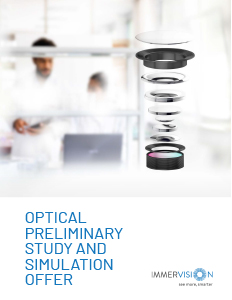Eradicate Your Camera
Vision Problems with
OPSSO
Camera Vision Systems Are Complicated
The sophisticated camera vision systems demanded by users of today’s products are extremely complex. Designing these systems requires high levels of expertise spanning multiple disciplines. It may be that you know what you want application-wise, but you aren’t sure how to translate this into an implementation-level specification, or how to fine-tune the system for use by artificial intelligence (AI), machine learning (ML) and by human viewing. Additionally, may be you aren’t sure if this design can be realized using off-the-shelf components, or if the system can be built within time and budget constraints, or…
Fortunately, we are experts in what we do, which is designing camera vision systems. Even better, we can make our expertise available to you. Our Optical Preliminary Study and Simulation Offer (OPSSO) can help you validate the performance of your camera vision system before you even start to develop it. And, even if you are already in development, OPSSO can leverage our expertise to enhance your ideas, optimize your system, save costs, minimize integration problems, and better meet your goals.
By leveraging the hundreds of thousands of hours of expertise that led to our proprietary simulation and analysis suite, the world-leading team at Immervision’s InnovationLab can fully evaluate every aspect of your design and return the detailed results from our study in just two to three weeks.
How We Can Help You to Succeed
A camera vision system comprises the lens assembly (which actually involves multiple sub-lenses), the sensor array, and any image processing software, such as distortion correction, colour correction, lens shading correction in the case of a wide-angle lens. The results may be fed to a display for human viewing or to an AI/ML system in the case of computer vision applications.
Suppose you’ve just taken possession of your new camera vision system. The first thing you are going to do is point it at a real-world view and display the results and/or feed them into a computer vision system. It would be unfortunate if you did not spend time to explore all options so you can make the right choice for your product. Perhaps the pixels at the edge of the image are too “scrunched up” to provide useful, intelligible, and actionable information, for example. In this case, you are about to head back to the drawing board and your project is going to suffer significant cost overruns and time delays.
By comparison, using our PGMS tool to simulate the lens assembly and sensor array, we can verify that your system will perform as desired, propose modifications to address any potential problems, provide suggestions with regard to selecting lens assemblies, sensor arrays, and system parameters, and also offer ideas with regard to manufacturability and integration.
The PGMS tool helps us to select optimal parameters for the system, such as Field of View, Sensor Resolution, and Distortion Profile. These key parameters determine the resulting image resolution profile that will have a significant impact on the lens design structure and sensor array characteristics. Using data and images generated by the system, we will generate a report and then discuss and review the results with your team.
There’s So Much to Know
The lens assemblies in modern cameras are actually composed of stacks of sub-lenses to correct for things like chromatic aberration. Until relatively recently, all of these sub-lenses were spherical in nature. The next development was the deployment of aspherical lenses that provide more freedom to correct aberrations and support smarter pixel management. More recently, freeform optical elements are breaking lens symmetry giving infinite degrees of freedom to reshape traditional image footprints. As just one example among many, the horizontal and vertical axes of the lens can be treated differently. If you are using a sensor with a 4:3 aspect ratio, then taking advantage of this one degree of freedom can give you 33% more usable pixels.

Using traditional wide-angle and aspherical lenses may result in pixels at the edge of the image being “squashed,” thereby minimizing the amount of useful data that can be retrieved from them. Cutting-edge camera vision system companies like Immervision now have the capability to create lens assemblies using state-of-the-art freeform technologies that support unlimited degrees of freedom, thereby allowing designers to reshape the image footprint to provide optimal sensor coverage, asymmetric pixel density, and more “usable” pixels containing better data.
Let’s Collaborate!
We enjoy collaborating with our customers on their innovative products. We’ve successfully designed a wide and diverse range of vision systems of our own and in partnership with our clients. Our signature results-oriented approach is rooted in tight collaboration between your team and our multidisciplinary scientists, optical designers, and image processing engineers, thereby enhancing your ideas, accelerating your project, and ensuring a successful outcome that exceeds your expectations.
Wherever you are in your development, from initial planning to early prototyping to pre-production, you really should consider taking advantage of Immervision’s Optical Preliminary Study and Simulation Offer (OPSSO). We would love to work with you on your unique camera vision system projects, so give us a call today and let’s start collaborating together!

Please fill out the form
Contact Us
We can’t wait to hear from you


